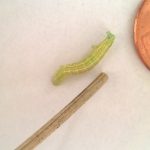Winter Moth on Attack
May 3, 2017
On April 21, I noticed a rolled leaf on the Twinberry at our house. I shuffled over to our apple tree.  Hmm. More rolled leaves. I jogged up to the orchard and every fruit tree that had leafed out showed this same leaf damage. What was this small green larvae with a stripe down it’s back?
Hmm. More rolled leaves. I jogged up to the orchard and every fruit tree that had leafed out showed this same leaf damage. What was this small green larvae with a stripe down it’s back?
The Honeycrisp got hit hard since the pest arrived just as the tree was leafing out. The fruit gods had mercy on the William’s Pride and Liberty because they were ahead of the curve at full blossom stage.
 The larvae had certain characteristics: an udder like organ toward the back end and also a two-barrel exhaust at the tail.
The larvae had certain characteristics: an udder like organ toward the back end and also a two-barrel exhaust at the tail.
You can’t have a good management strategy without knowing which critter you have. So, I looked at pages and pages of moth larvae on the internet. The closest I could come was the light brown apple moth. Lucky for us in Washington, it was not that. The larvae of the light brown apple moth have an anal fan of forklets.
Chris Looney, from WSDA came to the rescue to identify the pest as the winter moth (Operophtera brumata). (It’s within the group called loopers or inch worms.) It is common in our area and is not a leafroller, even though it rolls leaves. Its behavior is described more as sticking one leaf to another with its silk but, in fact, I can tell you it also rolls the leaves to make a nice hiding spot.
The udder looking appendage is actually called abdominal prolegs (versus the true legs up front) and the dual exhaust is simply the anal proleg.
“Damage to blueberry and apple crops is especially severe as the reproductive parts responsible for fruit can be destroyed before buds open fully.” (https://ag.umass.edu/landscape/fact-sheets/winter-moth-identification-management)
You can say that again. Just as the flower buds peek out and huddle together between tight cluster and pink stage, the caterpillar attacks.
Tree trunks can be checked for the tiny orange eggs during the winter. Eggs hatch when temperatures average around 55 degrees. Winter moth larvae are active for only about three or four weeks. After they have had their fill, they will dangle down to the ground on silk and burrow into the top layer of soil, where they will become dormant pupae until emerging as adult moths in late fall for their nighttime mating. The flightless females will climb up trees lay eggs on the tree bark, and die. Then next April those eggs will hatch and the cycle begins again. (http://www.arborcaretree.com/winter-moth-article.htm)
Sat, Jun 3, 2-4, Work Party
Sun, Jun 18, 2-4, Work Party
For organic management, we will try a dormant oil spray to focus on destroying the eggs this coming winter. This might only be partially satisfying since eggs are deposited virtually everywhere on trees and shrubs and new caterpillars can quickly migrate from untreated areas to the oil-treated plants by ballooning via their silken threads.
When applying oil sprays, temperatures should be above 45°F. Avoid spraying when temperatures may dip below freezing for 24-48 hours after application. (Temperatures below this threshold increase the risk of causing injury to the plant phytotoxicity – https://tinyurl.com/laqhckl). Certain weather conditions, such as when it is cool and cloudy, can also delay drying time and enhance the potential for injury. (https://ag.umass.edu/landscape/fact-sheets/winter-moth-identification-management)
Look-alikes: Blueberry sawfly (does not have pale stripes along body) Cankerworms (has two pair of prolegs, one shorted than the other), Bruce spanworm (found in the Northeast U.S.)
If anyone is interested, we are paying a bounty – 10 cents per larvae! Tell your friends about this lucrative offer.
Ruth

Wow, you’ve been busy!
Joan
Thanks for your kind, informative article.